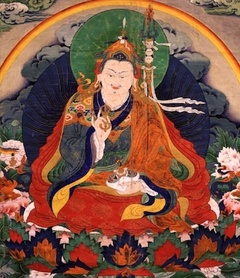Padmasambhava
English (35) | Deutsch (1) | Español (9) | Français (2) | 中文 (5) | བོད་ཡིག (35)
Texts by and about Guru Padmasambhava or Padmākara (padma 'byung gnas), the "Lotus-Born", who is credited with establishing Buddhism in Tibet:
Biography
revealed by Dudjom Lingpa
by
Tāranātha
Dzogchen
revealed by Pema Ledrel Tsal
revealed by Pema Ledrel Tsal
revealed by Pema Ledrel Tsal
revealed by Pema Ledrel Tsal
revealed by Pema Ledrel Tsal
revealed by Pema Ledrel Tsal
Empowerment
revealed by Pema Ledrel Tsal
revealed by Pema Ledrel Tsal
revealed by Pema Ledrel Tsal
Guru Rinpoche Prayers
by Longchen Rabjam and Jigme Lingpa
History
revealed by Pema Ledrel Tsal
Praise
by
Śāntigarbha
Prayers
revealed by Pema Ledrel Tsal
attributed to Menlungpa Mikyö Dorje
Sādhanas
revealed by Pema Ledrel Tsal
Sang Offering
Tantras
revealed by Pema Ledrel Tsal
revealed by Pema Ledrel Tsal
revealed by Pema Ledrel Tsal
revealed by Pema Ledrel Tsal
revealed by Pema Ledrel Tsal
revealed by Pema Ledrel Tsal
Testament
revealed by Pema Ledrel Tsal
revealed by Pema Ledrel Tsal
